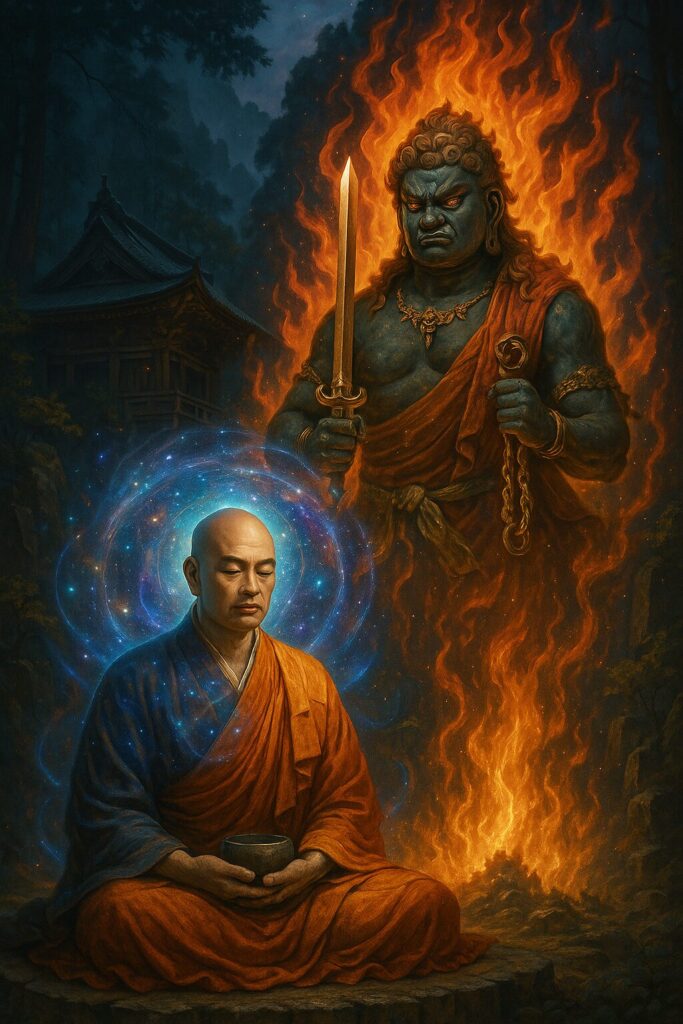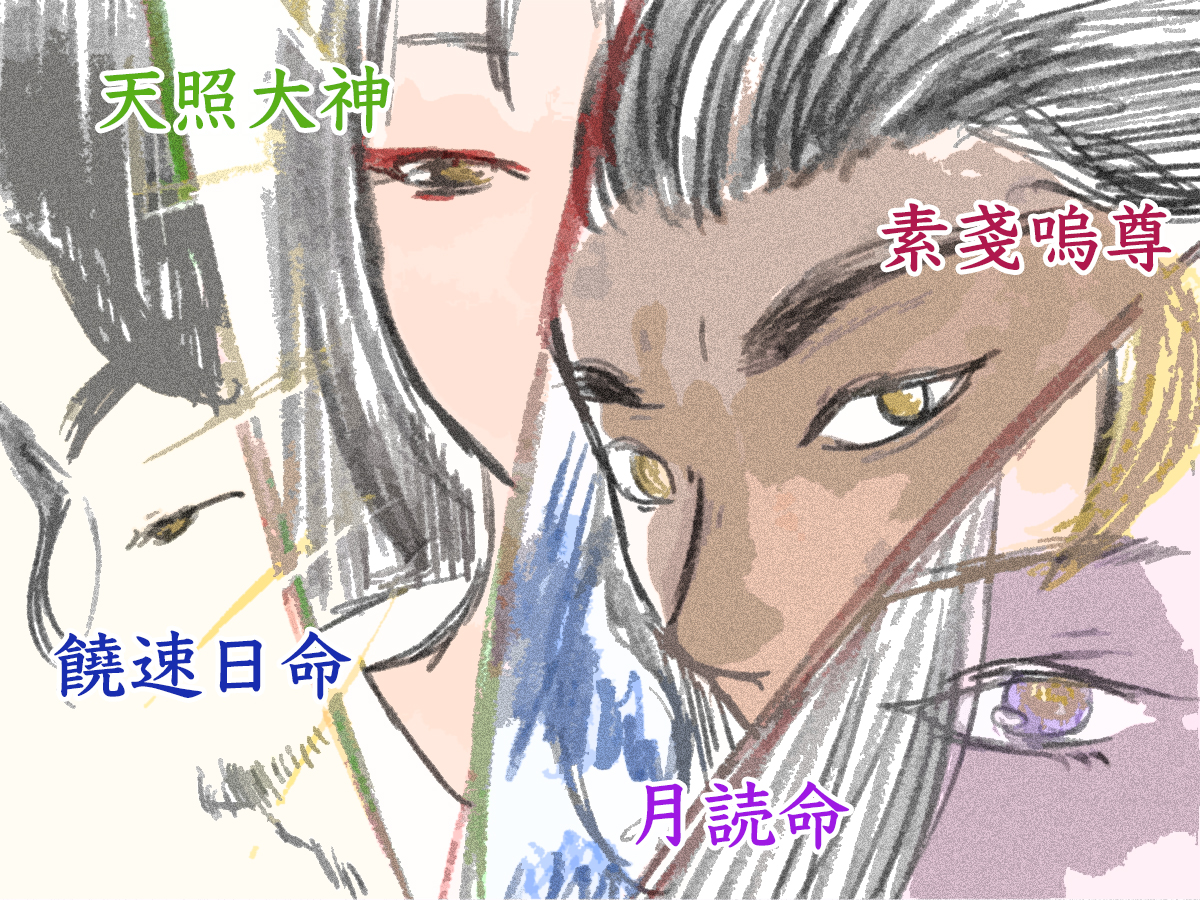When you hear the name Kōbō Daishi Kūkai, the founder of Japanese Esoteric Buddhism, many might feel a sense of solemn, indefinable “great power.” Kūkai was not merely a religious figure. His existence, transcending the boundaries of history and interwoven with myths and legends, continues to profoundly influence Japan’s spiritual culture.
- From the Cosmos? Kūkai the Traveler, and the Transcendent Will Within Fudō Myōō
- Kūkai’s Life: Intelligence and Intuition Beyond Human Comprehension
- Kūkai and Tokushima: Why it’s Called a Sacred Place
- Fudō Myōō: The Cosmic Guardian Manifested Within Kūkai
- Dragon Deities, Mandalas, and Star Memories
- Was His “Descent” a High-Dimensional Plan?
- Finally—A Call from Kūkai
- Differences Between Buddha and Kūkai
From the Cosmos? Kūkai the Traveler, and the Transcendent Will Within Fudō Myōō
Kūkai was an exceptionally great seeker who lived in the early Heian period and brought Shingon Esoteric Buddhism to Japan. But was he truly just a human being? Tracing his life, thought, profound ascetic practices, and numerous miracles, we eventually arrive at an intuition: “Kūkai might not be a being from this Earth.”
This feeling quietly resonates through time among many spiritual seekers. Was Kūkai a soul who came from the cosmos—a high-dimensional being reincarnated on Earth? Perhaps his teachings, transcending language and era, resonate so deeply with our hearts today because his soul carried the memories of a distant universe.
Esoteric Buddhism as a Code: A Key to Deciphering This World
The Esoteric Buddhism that Kūkai transmitted, particularly “mantras” (真言), is akin to a “cosmic language” designed to convey the structure of a world unreachable by human reason, through intuition and vibration. His teaching of “Sokushin Jōbutsu” (即身成仏) is not about waiting for salvation after death, but about attaining enlightenment in this very body.
This was revolutionary in Buddhism, and at the same time, it was a technique akin to “tuning into an interdimensional being while still in the human vessel.” Kūkai brought down to Earth the path to connect the infinite energy that fills the cosmos with human consciousness, as Shingon Esoteric Buddhism.
Kūkai’s Life: Intelligence and Intuition Beyond Human Comprehension
Kūkai (774–835) traveled to Tang China (then the height of Chinese culture) at the mere age of 31, learned the most advanced Esoteric Buddhism, and brought it back to Japan. While an academic monk, he displayed genius in many fields, including poetry, calligraphy, civil engineering, linguistics, and invention.
Of particular note are the following points:
- Prodigious Intellect: From a young age, he was well-versed not only in Buddhism but also in Confucianism, Taoism, astronomy, and music. He mastered all of Tang Esoteric Buddhism during a short stay (which usually takes over 20 years).
- Mystical Experience: While practicing asceticism in a cave at Cape Muroto, he recounts an experience where a “morning star (Venus)” flew into his mouth, becoming one with Dainichi Nyorai. After returning to Japan, he is said to have mastered the “Kokūzō Gumonji-hō” and gained superhuman memory and intuition.
This can be interpreted not merely as religious symbolism but as an “experience of communication with cosmic consciousness.” Similar reports exist from modern channelers and contactees (those who have communicated with cosmic beings).
Summary of Kūkai’s Life and Content
- Birth and Origin (774 CE): Born in Kagawa Prefecture. A figure born from the fusion of different cultures: his father from the Saeki clan (Jomon lineage), his mother from the Ato clan (immigrant lineage).
- Youthful Studies and Struggles: Although destined for an elite course in central administration due to his brilliance, he dropped out of university due to a mismatch with his own inquisitive mind (“What is humanity?”). He was drawn to Buddhist scriptures but questioned the formalistic understanding of the time.
- Mountain Asceticism and Encounter with Akasagarbha Bodhisattva: While living like a beggar in paper robes, he practiced the Kokūzō Gumonji-hō for 100 days at Cape Muroto. Through meditating on the morning star (Akasagarbha Bodhisattva), he had a mystical experience and achieved enlightenment.
- Journey to Tang as a Kentōshi (804 CE): From being a mere private monk, he became a formal one, mastering the profound teachings of Esoteric Buddhism in just three years. He inherited the orthodox lineage of Esoteric Buddhism from Master Huiguo (Keika Ajari) and received the title “Henjō Kongō.”
- Return to Japan and the Doctrine of Sokushin Jōbutsu: He preached the teaching that one can attain enlightenment in this life (Sokushin Jōbutsu). With the revolutionary idea that “anyone can become a Buddha through practice,” he paved the way for Japanese Esoteric Buddhism.
- Conflict with Saichō and Aftermath: The breakdown of his close relationship with Saichō. Saichō developed Mount Hiei as an educational institution, later producing many famous monks (Ennin, Enchin, Hōnen, Shinran, etc.).
Particularly Fascinating Points
- The Blank Seven Years: The “period with almost no records” between Kūkai’s mastery of the secret teachings of Akasagarbha Bodhisattva and his journey to Tang is depicted as a time of asceticism and exploration, combining mysticism with realism.
- Description of the Morning Star Experience: The depiction of the morning star entering his mouth in the cave is impressive both as a mystical experience and a religious turning point.
- Balance of Study and Practice: The flow from questioning Confucianism at university → questioning Buddhist formalism → mountain asceticism → enlightenment as a real experience is very natural.
Kūkai and Tokushima: Why it’s Called a Sacred Place
- Ryozen-ji Temple, the Starting Point of the Shikoku Pilgrimage: Ryozen-ji Temple, the first temple of the Shikoku Pilgrimage located in Naruto City, Tokushima Prefecture, is considered the starting point of this spiritual journey. It is said to have been founded by Kūkai.
- Tokushima as a “Dojo for Practice”: The Shikoku Pilgrimage is divided by region as follows:
- Tokushima Prefecture (Temples 1-23): Dojo of Practice
- Kochi Prefecture: Dojo of Bodhi (Enlightenment)
- Ehime Prefecture: Dojo of Nirvana
- Kagawa Prefecture: Dojo of Attainment Within this, Tokushima is designated as the “Dojo of Practice” and is believed to be where Kūkai first deeply engaged in ascetic training.
- Mount Tsurugi and Kūkai’s Legends: Mount Tsurugi (剣山) in western Tokushima Prefecture has long been considered a sacred mountain. There are legends that Kūkai trained here and that one of the Imperial Regalia of Japan, the Kusanagi Sword, lies dormant within Mount Tsurugi, having been sealed underground by Kūkai. Furthermore, theories of “Mount Tsurugi = Sumerian origin” and “Moses and the Jewish people came here” are also topics in the spiritual community.
- “Awa Province” Said to Be Protected by Kūkai: Kūkai trained in his youth in “Awa Province” (present-day Tokushima). It is a land of mountain worship and dragon deity worship, and there are traditions that Kūkai protected this land as a “spiritual barrier.” Numerous place names and legends, such as Kōbō-sui (Kōbō’s Water) and Kōbō-ido (Kōbō’s Well), are attributed to Kūkai.
The Sacred Aspect of Tokushima: Connection to Dragon Deities and Jomon
- Strong Dragon Deity Beliefs: Tokushima, with rivers like the Yoshino River and Naka River, is deeply connected to water deities, i.e., dragon deities. Legends connecting Kūkai and dragon deities exist in places like Kamiyama Town and Iwato Shrine in Mima City. There are also many Jomon period archaeological sites, indicating it was a land of “prayer” from ancient times.
Tokushima is seen as “Kūkai’s Opened Gate of Practice.” For Kūkai, Tokushima was the “land of beginning,” where he protected dragon deities and Mount Tsurugi, transforming Tokushima into a “spiritual entrance” as a sacred site. There’s a view that Kūkai’s intention was to guide people’s spiritual growth, starting from Tokushima and progressing through the pilgrimage.
Fudō Myōō: The Cosmic Guardian Manifested Within Kūkai
Particularly symbolic is Kūkai’s relationship with Fudō Myōō (不動明王). Fudō Myōō, with his fearsome countenance and flames on his back, is considered a protective deity who severs human delusions. This is not just a Buddhist symbol but the embodiment of a “transcendent being” deeply imprinted on Kūkai’s psyche.
Records show that in his later years, during Shingon rituals, Kūkai frequently invoked Fudō Myōō before his eyes and conversed with him. From a spiritual perspective, it’s possible to consider Fudō Myōō a “higher being” who resonated with Kūkai’s soul even before his descent to Earth. Fudō Myōō may have been Kūkai’s spiritual guide and the guardian of the “program” to fulfill his cosmic mission.
What is Fudō Myōō?
Fudō Myōō is the central figure among the Five Great Myōō in Esoteric Buddhism and is considered an “emanation of Dainichi Nyorai.” He is depicted with an angry expression, burning away delusions to save sentient beings.
- Right hand: Sword (cuts through delusions)
- Left hand: Kenjaku (snare: catches and saves confused beings)
- Behind him: Flames (symbol of purification)
- Fudō Myōō’s Indian Origin: The prototype of Fudō Myōō is the Indian guardian deity “Acalanātha.” This was translated as “Fudō Myōō” in China and transmitted to Japan along with Tang Esoteric Buddhism.
- Kūkai Brought it to Japan: Kūkai traveled to Tang as a Kentōshi in 804 and learned all of Esoteric Buddhism from its supreme master, Huiguo (Keika Ajari). This, of course, included Fudō Myōō worship. After returning to Japan, Kūkai systematically transmitted and spread Fudō Myōō’s doctrines, mantras, rituals, and iconography. In essence, he is the founder of Fudō Myōō worship in Japan.
Dragon Deities, Mandalas, and Star Memories
Kūkai’s constructed mandala world—especially the “Womb Realm” and “Diamond Realm” mandalas—can be seen as visual representations of the cosmic structure. It was as if he mapped out a visible universe on Earth.
He also integrated dragon deity worship into Mount Kōya, superimposing the energy of the natural world with cosmic rhythms. Dragon deities are guardians of water veins and ley lines, and since ancient times, they have also been said to be the guardians of “star pathways.” Kūkai’s connection with dragon deities is also proof that his soul stood at the “intersection of heaven and earth.”
Kūkai’s Involvement with Dragon Deities
- Ryūjin Onsen: A hot spring said to have been opened by Kūkai after receiving a divine message from Nanda Dragon King, which is also the origin of the name Ryūjin Onsen.
- Mandala Waterfall: There is a legend that when Kūkai was secluding himself to decipher the truths of the universe, Nanda Dragon King appeared and told him to “spread this land to the world.”
- Murō-ji Temple: Located on Mount Murō, a place rich in dragon deity worship related to rain and water, and known as a training ground for Shingon Esoteric Buddhism.
Was His “Descent” a High-Dimensional Plan?
The confusion, anxiety, and loneliness of modern society resonate with the era Kūkai lived in. Perhaps our renewed attraction to Kūkai is to remember the wisdom of “reconnecting with our inner cosmos, rather than changing the outer world.”
Kūkai said: “The mind connects to the void, and the void dwells in the mind.” This is his core spiritual realization that the universe and humans are not separate. In other words, we too are “travelers” living on Earth, carrying high-dimensional memories within us, just like Kūkai.
Finally—A Call from Kūkai
If you are drawn to the name Kūkai, it’s no coincidence. Perhaps a promise made long ago among the stars is etched within you. Like the flames of Fudō Myōō, it’s a quiet yet intense inner impulse. Walk your path without losing sight of its meaning. Truly, Buddhas never tell people to practice the Dharma. Learning is a personal journey for the growth of the soul. Kūkai preached this.
Kūkai is believed to have not allowed his body to decay after death, continuing his meditation in Okunoin. His appearance truly resembles a “mummified Buddha” or “light body transference,” close to the characteristics of cosmic beings. Perhaps he is still praying in a place unseen by people, waiting for the day when this star will once again experience a cosmic awakening.
Differences Between Buddha and Kūkai
Buddha (Gautama Buddha) was the founder of Buddhism, who preached universal teachings.
On the other hand, Kūkai, building upon Buddha’s teachings, introduced Esoteric Buddhism to Japan and established his own unique Buddhist philosophy. Both are important figures in Buddhism, but their teachings and positions differ.

.
.
.
↓The identity of Fudo Myoo.



コメント